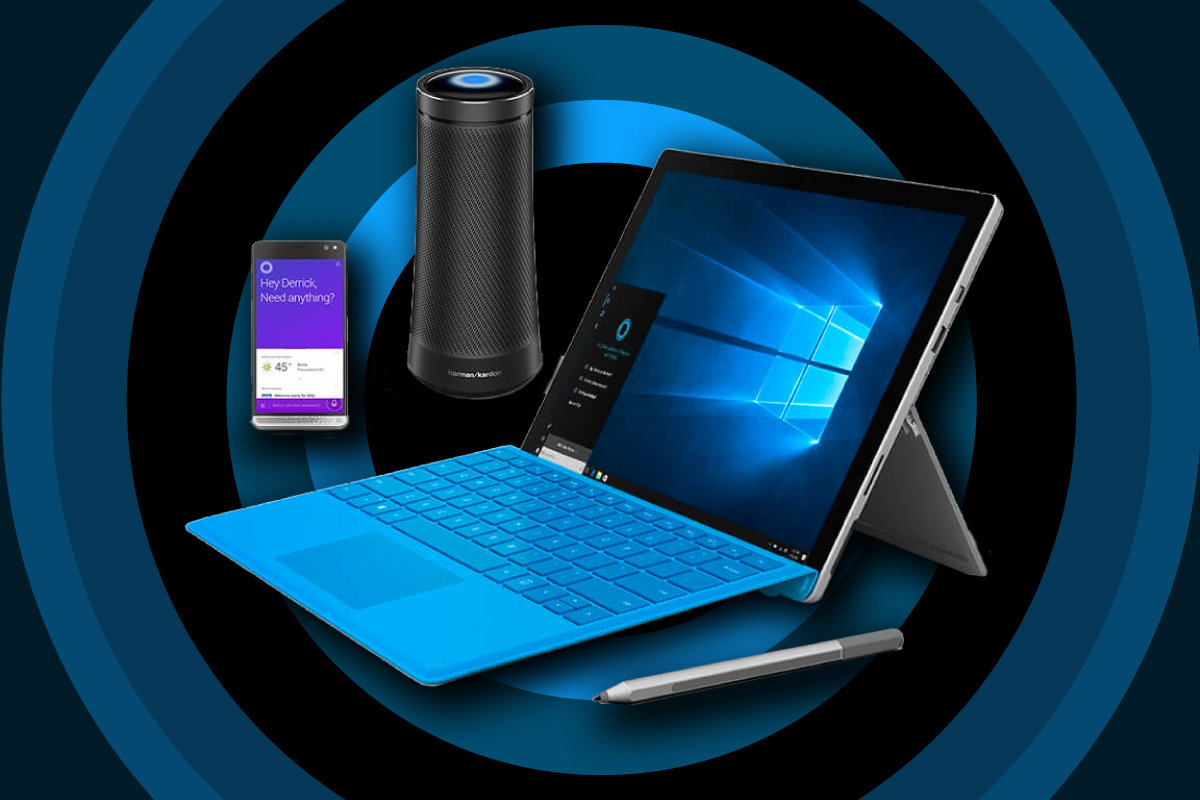Microsoft’s digital assistant Cortana can make your life easier and more efficient — if you know how to really take advantage of it.
Microsoft’s digital assistant Cortana was one of the major additions to Windows 10 when it first came out. But it was launched back in December 2015, and it’s changed quite a bit since then. Over the years, it’s had new features added, and then others taken away. Depending on which version of Windows you’re using, it may be integrated directly into the Windows Search box, or run as an entirely separate app.
No matter which version you use, though, it’s a very useful tool and can do a lot for you, including alerting you to upcoming meetings; searching your PC and the web; telling you about the weather, news, and sports; and a lot more.
To help you get the most out of Cortana, I’ve put together some of my favorite tips for using it — including using Cortana to manage your Google Calendar, send you reminders, and track packages and flights.
But because Cortana works very differently depending on what version of Windows 10 you use, I’ve separated this article into two parts — one that covers tips for Cortana using the latest version, the Windows 10 May 2020 Update (version 2004), and the other with tips for the previous two versions, the Windows 10 November 2019 Update (version 1909) and the Windows 10 May 2019 Update (version 1903). Use the table of contents in the left margin or below to jump to the appropriate section for you.
(Note: This article assumes that you’re already familiar with the basics of Cortana. If you have Windows 10 version 1903 or 1909 and want help getting started, see the “Cortana and search” section of Computerworld’s “Windows 10 cheat sheet.” If you have Windows 10 version 2004, see the Cortana section of our Windows 10 May 2020 Update review.
Tips for Cortana in Windows 10 version 2004
Before we head into the tips for the Windows 10 version 2004, we should cover a bit of background. Cortana used to be integrated in the Windows search box: Whether you performed a search by speaking or typing, the results were delivered in the Cortana pane. But with last year’s Windows 10 May 2019 Update, Microsoft separated Cortana from the Windows search box. And in the new Windows 10 May 2020 Update, Microsoft went ever further and turned Cortana into its own app that works like any other Windows 10 app, including running in a resizable window that can be moved around the screen.
So if you have version 2004 of Windows, the only way to use Cortana is to run the app. You can start it by clicking the Cortana icon in the taskbar just to the left of the search box, pressing the Windows key + C, or saying “Cortana.”
Once you start the app, to perform a Cortana search, you say “Hey Cortana” and speak your search, or click the Cortana icon to the right of the search box and speak, or press the Windows key + C and speak or type.
When you ask Cortana a straightforward question or issue a straightforward command, Cortana displays the result onscreen and reads it to you. However, if you ask a more complicated question that requires a display of web links, Cortana will show the links in the Edge browser.
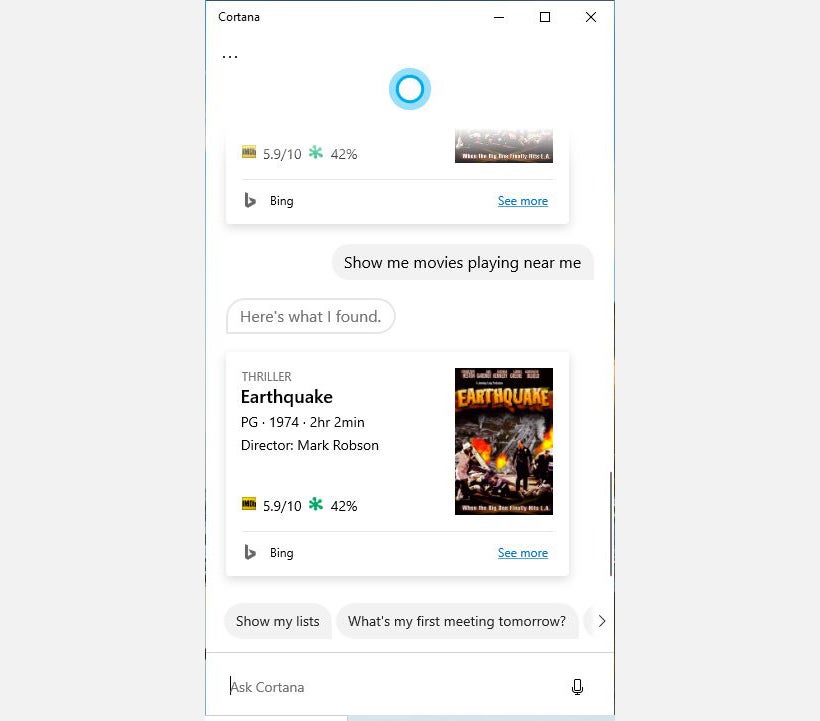 IDG
IDGIn the previous version of Cortana, you often had to fill out on-screen forms to create reminders. However, the Cortana app now offers a chat-like experience, so you instead speak or type using plain English words. Cortana may ask questions to clarify what you want done, tell you it’s created the reminder, or say it can’t create the reminder. As with chat or texting, it displays your previous interactions, so you can scroll back and see your questions and Cortana’s answers.
When you first install the May 2020 update, you may need to customize Cortana so you can activate it by voice or by pressing the Windows key + C. To do it, click the Cortana button to the right of the search box to launch Cortana, then click the three horizontal dots at the top left of the screen and then click the “Settings” button (it’s in the shape of a gear) and select “Talk to Cortana.” From here you can tell Cortana to respond when you say “Cortana” or press the Windows key + C. And you can also choose whether you’d like to interact with Cortana via typing or speaking and typing.
You can also remove the Cortana button to the right of the search box. Right-click the taskbar and uncheck “Show Cortana button” from the menu that appears. (You can even turn off the search box in this way. Right-click the taskbar, select Search, and click Hidden.)
One final note before we begin: Cortana’s capabilities were significantly scaled back in the Windows 10 May 2020 Update. It can no longer play music, control streaming video services like Netflix or Hulu, control smart home appliances, or do other consumer-oriented tasks. And it can’t do many smaller tasks either, such as creating location-based reminders — for example, having it tell you to buy Cherry Garcia ice cream when you’re at a Whole Foods store.
Those familiar with previous versions of Cortana will likely notice that it has been stripped down in another way as well. There’s no longer a notebook that lets you do things such view and edit your reminders. In many cases, you simply can’t do the things with Cortana that you used to set up through the notebook — the various consumer tasks, notably.
We’re watching Cortana closely, though. So check back regularly in case Microsoft decides to give it some more power in the future.
Set and use reminders
One of Cortana’s most useful features is the way in which it can remind you about tasks or upcoming events. It’s very simple to set a reminder — just say or type in plain English what you want to be reminded about — for example, “Create a reminder for my weekly Wednesday 1 pm Zoom meeting.”
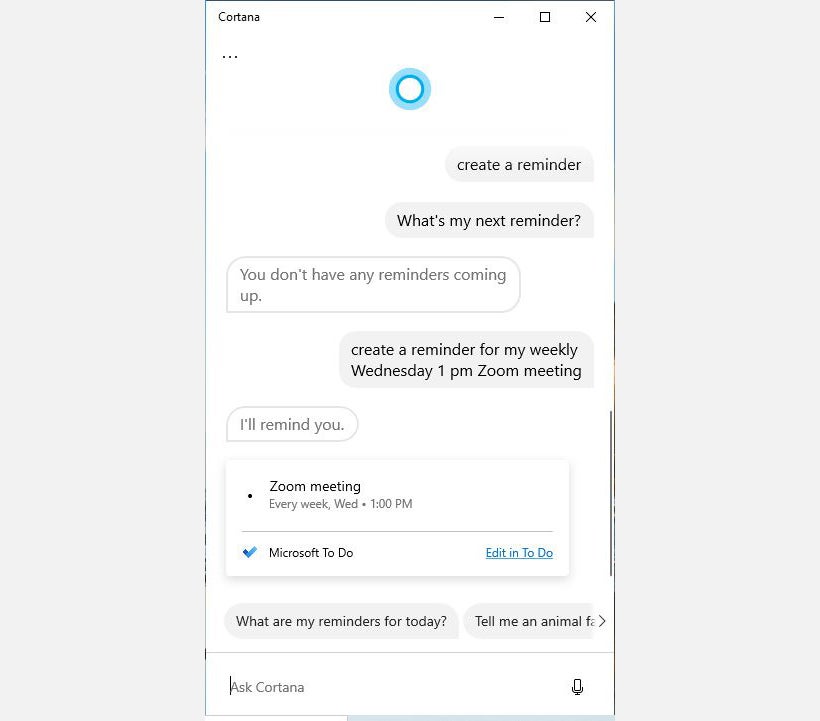 IDG
IDGIn order for Cortana to pop up alerts about the reminders you’ve set, you need to turn on Windows 10’s notification feature. To do it, go to Settings > System > Notifications & actions and then turn the slider on in the “Get notifications from apps and other senders” section.
Note that if you don’t give Cortana enough information to create the reminder, it will ask you a follow-up question. So if you say “Create a reminder for my weekly meeting” but don’t specify at what time you want to be reminded, Cortana will ask “When should I remind you?” Speak or type the answer, and your reminder will be created.
You can set reminders in the same way for time and contacts. If you want to be reminded to fill your car with gas tomorrow morning, for example, say or type “Remind me to get gas tomorrow morning.” A screen will pop up asking for more details, such as the exact time and whether it should be a recurring reminder.
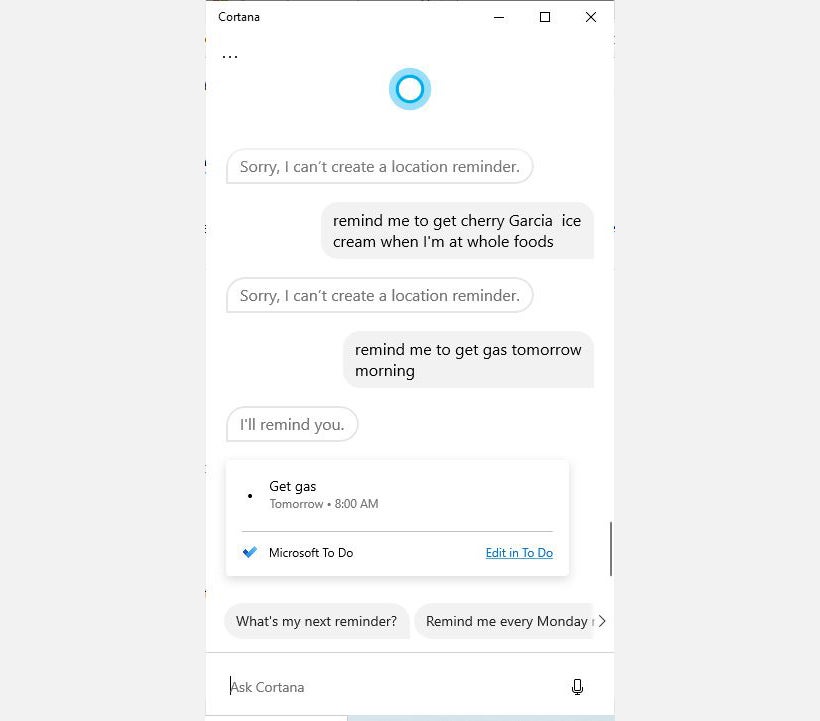 IDG
IDGYou can also tell Cortana to remind you to do something when you interact with someone in your contact book. So if you want to remind yourself to ask your friend Lydia about a dinner invitation, say “Remind me to ask Lydia about a dinner invitation.” A screen pops up asking for the contact’s name if Cortana didn’t recognize it. Then the next time you send or receive an email with that person, you’ll get the reminder.
When you’ve set a reminder, and it’s time for the reminder to alert you to do something, the alert doesn’t come via Cortana. Instead, it’s sent as a Windows notification.
In previous versions of Cortana you could easily view, manage and edit your reminders via Cortana’s notebook. But Cortana no longer has a notebook, and so it’s not easy to do anymore. However, you can do it using a little-known Microsoft tool called To-Do. Head to https://to-do.live.com/ and log in using your Microsoft account information. (You can install the Microsoft To Do app from the Microsoft Store if you prefer to use an app rather than do it on the web.)
Click Tasks and you’ll see a list of all of your reminders. Click any reminder and you can edit it, for example by having it repeat, changing the day and time, adding it to your calendar, dismissing it and so on.
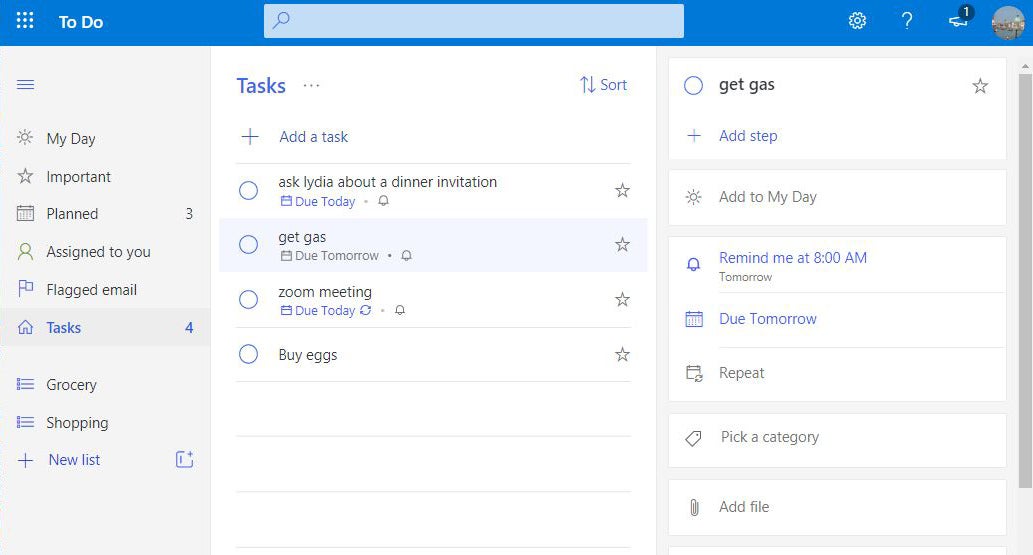 IDG
IDGManage your Google Calendar with Cortana
Windows 10 includes a built-in calendar app that works with Cortana. However, if you’re a Google Calendar user, you can get Cortana to integrate with that as well, so you can use Cortana to create and edit appointments, and show you your schedule with Google Calendar in the same way as you do with the built-in Windows 10 Calendar app.
To do it, you first need to integrate your Google Calendar with the Windows 10 Calendar. First, launch the Calendar app by typing “calendar” into the Windows 10 search box, then clicking the Calendar app icon that appears.
Next, click the Settings icon on the lower left of the Calendar screen — the icon is in the shape of a gear. When the Settings pane appears, select Manage Accounts > Add account. From the screen that appears, select Google. You’ll be asked to sign in with your Google account information. Follow the prompts to create the account.
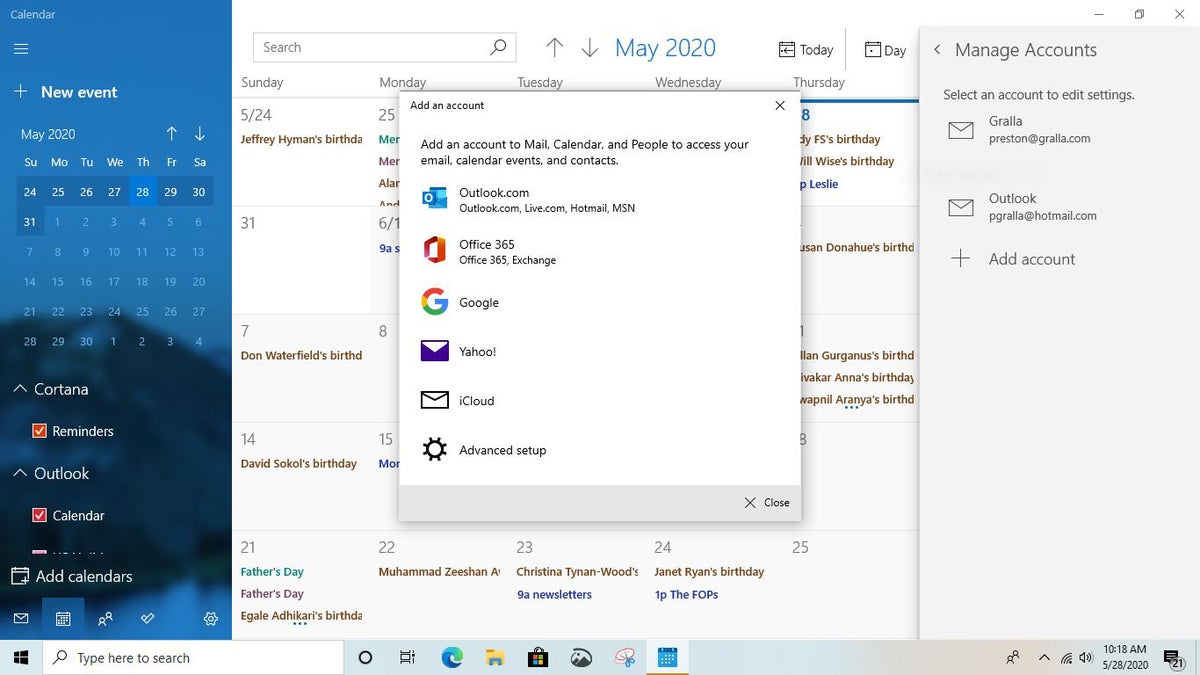 IDG
IDGThat’s all it takes. From now on, your Google calendar will sync with the Windows 10’s Calendar app. So, for example, if you ask Cortana to “create appointment,” you’ll be able to tell Cortana the details, including the date, time, and purpose. If any information Cortana needs is missing, it will ask you, and you merely need to provide the answer. Cortana will add the event to your Calendar. Regardless of which calendar you add an event to, both Google and Windows 10 Calendar will remain in sync.
Also, when you ask to see your schedule — such as by asking “What’s my schedule today?” — Cortana will show you the events from all of your calendars, including Google.
One downside is that you can’t add events to sub-calendars on Google Calendar (like “home” or “work”) with any regular success. Sometimes it works, and sometimes it doesn’t.
Use alternate search engines and browsers with Cortana
The latest version of Cortana is designed solely for tasks such as setting reminders, interacting with your calendar, and similar tasks, but not at all for general queries you might ask a search engine. So if you ask Cortana an open-ended question that requires that it search the web and then display the results in a browser — for example “Why are deepfakes dangerous?” — it uses Microsoft’s Bing search engine to do the search. And it then uses the Microsoft Edge browser to display the results. To do that, it first displays the text of your question back to you, for example, “Search for ‘Why are deepfakes dangerous.’” You then click that text, and Edge launches and displays the search results.
However, if you’d prefer, you can have a different browser display the results. It’s easy to do. Just change your default web browser. To do it, go to Settings > Apps > Default Apps and scroll down to “Web browser.” Click the Microsoft Edge icon. It will display the browsers you’ve installed. Click the browser you want to use, and from then on, Cortana will use that browser to display results of searches. And it will also be your default browser for using Windows in general.
Even when you do that, though, Cortana will still use Bing to perform the search. You can, though, instead have Cortana use Google, DuckDuckGo, Yahoo or Baidu to perform the search. To do that, you’ll also have to make your default web browser either Chrome or Firefox.
If you want to change from Bing to an alternate search engine and use Chrome as your default web browser, first follow the above steps to tell Windows to user Chrome as your default browser. Then go install the Chrometana Pro extension. Ignore the instructions about having to download and use a program called Edge Deflector — you only need to do that if you have a Windows 10 version previous to the May 2020 Update.
Click the Chrometana Pro extension on the upper-right of the screen in Chrome, then choose your new default search engine for Cortana. From now on, your web searches launched from Cortana will use whatever search engine you choose and will display the results in Chrome.
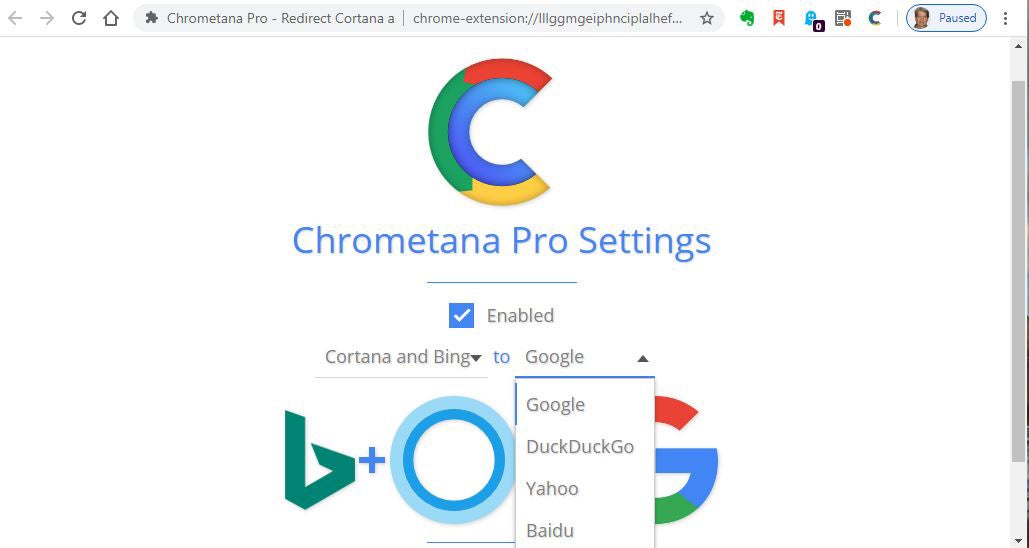 IDG
IDGNote that there’s also a version of Chrometana Pro for Firefox. To use it, first make Firefox your default web browser, then install Foxtana Pro, and use the same instructions outlined for Chrometana Pro for Chrome.
Use natural-language queries
Cortana is a lot smarter than you think: It lets you use natural-language queries — in other words, make requests of it using plain English (or whatever your language is), rather than having to use specific words.
For example, to send an email to a contact, you can say, “Send an email to Jane Doe.” Cortana will look through your contacts, find the person to whom you want to send the email, and then let you fill out a form onscreen to create and send the email without having to go into a mail app. If you’ve linked your Outlook account to another account, such as a Gmail account, it will look through that as well. And if it finds multiple matches for the person’s name, it will ask you which address you want to send the mail to.
Check your calendar for Cortana-created information
Cortana can automatically add events to your calendar based on emails you receive — for example, it will add airline flight info to your calendar if you receive a flight confirmation via email. Keep in mind, though, that it only does this with mail sent to an Outlook.com account or to corporate Outlook users. If the information goes to a different service, such as Gmail, it won’t work.
Miscellaneous cool stuff
There are a variety of other useful and/or fun things that Cortana can do for you. A few of my favorites:
- You can track flights by saying the flight number, including the symbol for the airline (for example, B6 for Jet Blue or AA for American Airlines).
- You can ask Cortana to perform simple calculations: Just say, “Hey Cortana, what’s five hundred twenty-one times twelve minus twenty-six divided by three?”
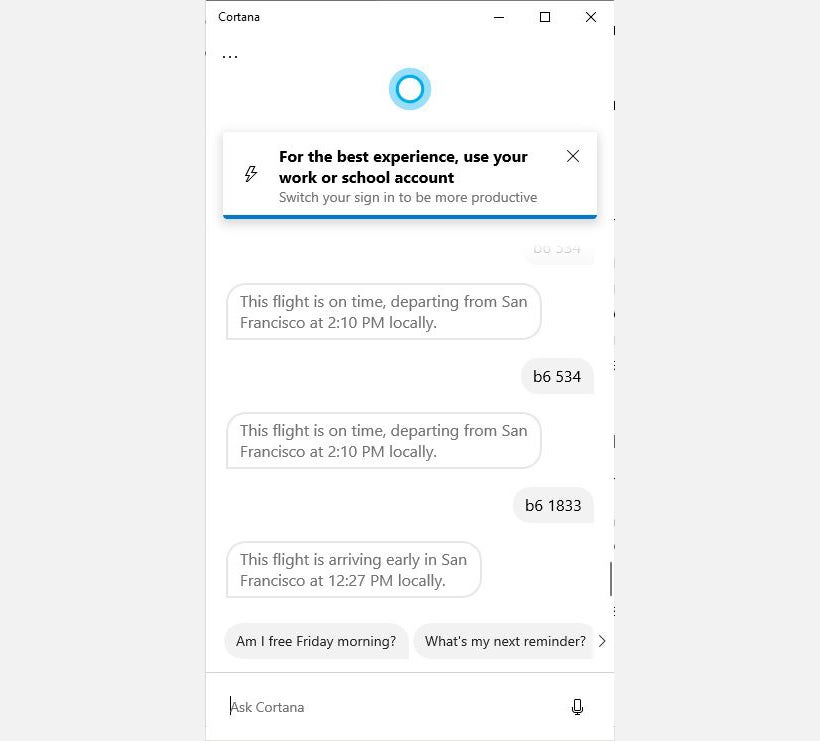 IDG
IDGTips for Cortana in Windows 10 versions 1903 and 1909
If you’ve got the Windows 10 May 2019 Update (version 1903) or the Windows 10 November 2019 Update (version 1909), we’ve got good news for you: The version of Cortana found in those releases is much more powerful than the version that’s in the Windows 10 May 2020 Update (version 2004). So there’s a lot more to learn, and lot more it can do for you.
Before we head into the tips, we should cover a bit of background. Cortana used to be integrated in the Windows search box: Whether you performed a search by speaking or typing, the results were delivered in the Cortana pane. But with the Windows 10 May 2019 Update, Microsoft separated Cortana from the Windows search box.
So if you have Windows 10 version 1903 or 1909, Cortana doesn’t respond to typed searches; if you type in a search, Windows Search will deliver the results. To perform a Cortana search, you say “Hey Cortana” and speak your search, or click the Cortana icon to the right of the search box and speak, or press the Windows key + C and speak.
When you ask Cortana a question, Cortana displays the result onscreen and reads it to you if you ask a straightforward question or issue a straightforward command. However, if you ask a more complicated question that requires a display of web links, Cortana will show the links in the Edge browser.
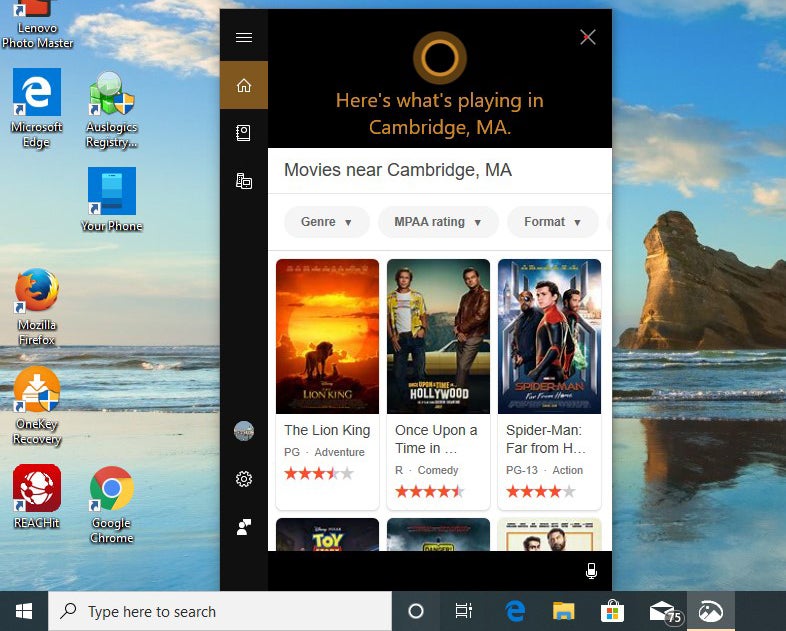 IDG
IDGWhen you first install the May 2019 or November 2019 update, you may need to customize Cortana so you can activate it by voice or by pressing the Windows key + C. To do it, click the Cortana button to the right of the search box to launch Cortana, then click the “Settings” button (it’s in the shape of a gear) and select “Talk to Cortana.” From here you can tell Cortana to respond when you say “Hey Cortana” or press the Windows key + C.
You can also remove the Cortana button to the right of the search box. Right-click the taskbar and uncheck “Show Cortana button” from the menu that appears. You can even turn off the search box in this way. Right-click the taskbar, select Search, and click Hidden.
Connect your accounts, apps, and services to Cortana
One way to extend the power of Cortana is to connect it to an account — for example, LinkedIn — so that when you ask Cortana to do something, it can look through information in that account and give you additional information about your request. Cortana can do more as well, including playing music through a service such as Spotify or controlling smart home appliances. And Cortana can work with Windows 10 apps, such as finding a show and playing it on Netflix or Hulu, or asking Fitbit how many steps you’ve taken in a day. Microsoft calls these types of actions “Cortana skills.”
To get started, launch Cortana an any of the ways I outlined previously in this article, and when Cortana appears, click the icon of the notebook in the left-hand navigation panel. Click the Manage Skills tab at the top of the screen that appears and look under Connections, which is separated into four sections: Manage accounts, Music, Connected Home and Microsoft family. (Note that company-owned machines may not have all four sections.)
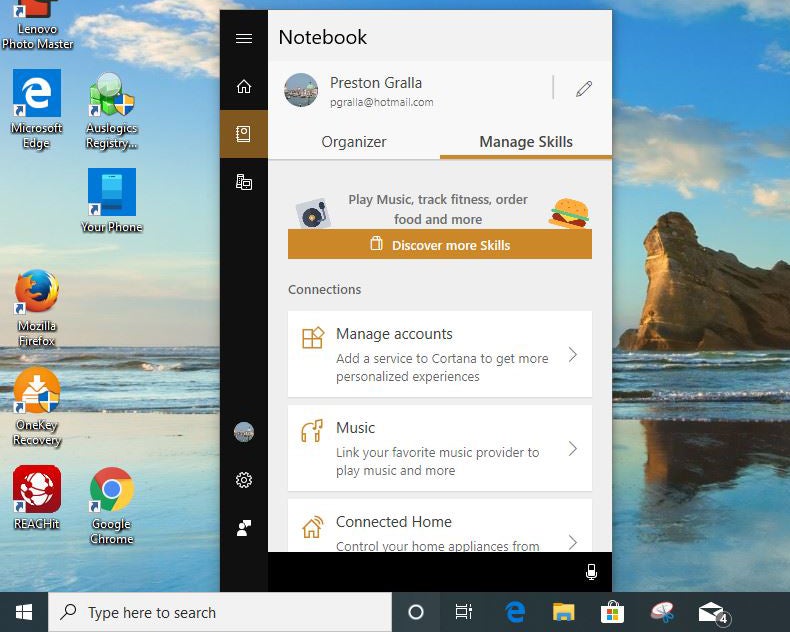 IDG
IDGClick the appropriate box — for example, Music if you want to have Cortana play music via Spotify. Then click the service you want to connect. As I write this, only three music services are available: iHeartRadio, Spotify, and TuneIn. Follow the prompts to add the account and then start playing music.
To control home appliances, click Connected Home, then from the screen that appears, click the appliance you want to control — for example, the Nest smart thermostat. Click Connect and then follow the prompts. It will probably help if you check the manual of your smart home appliance before trying this.
For other services, select “Manage accounts.” You’ll see a list of available services, such as LinkedIn, Gmail, Office 365, Outlook.com, Spotify, and Skype. (Office 365 integration is available only if you have a business Office 365 account, not a personal one.) At the top you’ll see the accounts that have already been linked to Cortana. Below them is the list of available services you can connect to. Click the Link button underneath any to which you want to connect and then follow the prompts. You’ll typically need to enter the information you use to log into the account.
If you want to share events and calendars with family members, click Microsoft family. That will launch the Edge browser to a web page that helps you create a “family group” that will let you do that. Click “Create a family group” and follow the prompts.
There are additional accounts you can link to Cortana for a variety of other skills, such as linking to your Fitbit account to get an activity summary, or even ordering pizza from Domino’s. To link to them, go to the main Manage Skills screen, then click the “Discover more Skills” button. That will launch the Edge browser to a page with a list of services you can use. Click any for instructions on how to connect to it.
Note: If you’ve changed your default browser from Microsoft Edge, the “Microsoft family” and “Discover more Skills” buttons won’t work — no browser will launch.
The benefits you’ll get from linking your accounts to Cortana vary according to the account. For example, if you link Cortana to LinkedIn, when it reminds you of a meeting, it will look to see if any of the people at the meeting are LinkedIn members. If they are, it will grab their information — including their LinkedIn profile photo, their job title, and their company. You can then click on the person’s name to jump to their LinkedIn profile.
Note that in many instances, you don’t need to manually add a skill to Cortana to have it perform tasks for you. As long as you’ve installed the app, Cortana automatically integrates with it. A number of popular apps, including Netflix, Hulu, and Uber, integrate with Cortana like this. For example, if you want to play the TV series Master of None on Netflix, you can say, “Hey, Cortana, Netflix find Master of None.” Use the same syntax for Hulu — for example, “Hulu find Spiral” if you want to find and play the French police show. You can also play and pause using voice commands.
Keep in mind that you have to use the precise syntax required for each app — you can’t type or speak using real-life, natural language. And it’s different for each app. For Netflix and Hulu, for example, the syntax is “[name of app] find [name of show].” You can’t say, “Play Master of None on Netflix” or even “Netflix play Master of None” and have it work.
Set and use reminders
One of Cortana’s most useful features is the way in which it can remind you about tasks or upcoming events. It’s very simple to set a reminder — just say “Remind me” to Cortana. From the screen that appears, fill in the form by typing the person, place, time, or thing that you want to be reminded about. If you prefer, you can bypass the form and say something like “Remind me about my tennis game today at 6 pm.” You can also just say “Remind me,” and then when Cortana asks you questions about what you want to be reminded about, speak the answers.
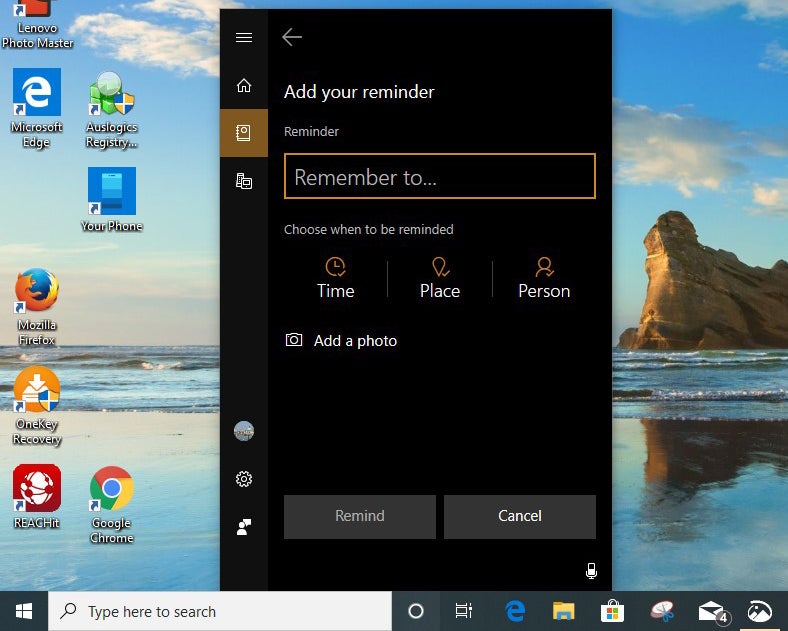 IDG
IDGYou can also set a reminder by selecting the notebook icon in the Cortana pane as detailed in the previous tip, clicking the Organizer tab, and then, in the Reminders section, selecting “Create a reminder” and typing in the required information.
In order for Cortana to pop up alerts about the reminders you’ve set, you need to turn on Windows 10’s notification feature. To do it, go to Settings > System > Notifications & actions and then turn the slider on in the “Get notifications from apps and other senders” section.
Let’s start with location. Say that you always want to be reminded to buy a pint of Ben and Jerry’s Cherry Garcia ice cream when you’re near your favorite supermarket — Whole Foods, for example. Tell Cortana “Remind me to get Cherry Garcia ice cream when I’m at Whole Foods.”
A screen will appear, showing the address of any nearby Whole Foods stores; Cortana will ask you which one to set a reminder for — or whether the reminder should show up when you’re in any Whole Foods. Then, the next time you’re there, Cortana will remind you to indulge in your ice cream addiction.
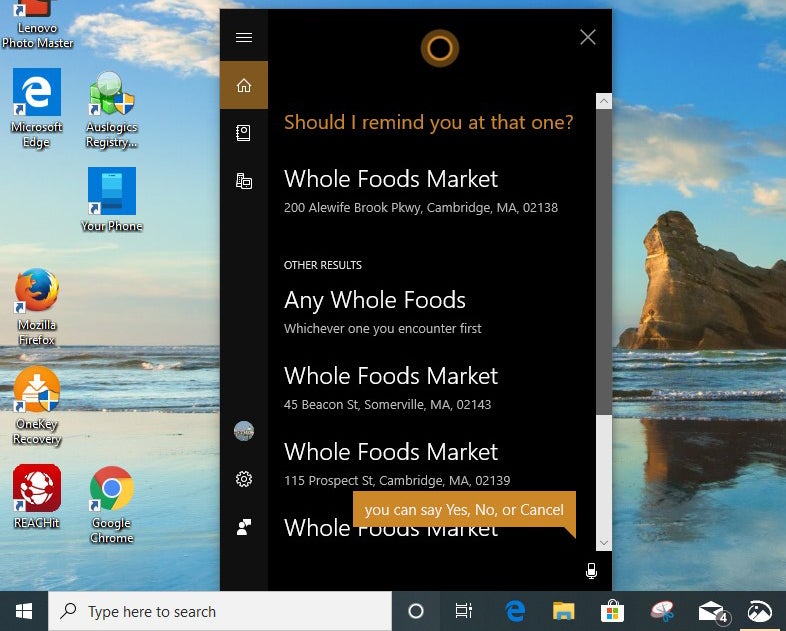 IDG
IDGNote that you’ll need to have location services turned on for this feature to work. To turn the services on, go to Settings > Privacy > Location. Click the Change button, and from the screen that appears, move the slider to On. Also, if the place isn’t one that Cortana readily recognizes, it will ask you for more information or have you type in the address yourself.
You can set reminders in the same way for time and contacts. If you want to be reminded to fill your car with gas tomorrow morning, for example, say or type “Remind me to get gas tomorrow morning.” A screen will pop up asking for more details, such as the exact time and whether it should be a recurring reminder.
You can also tell Cortana to remind you to do something when you interact with someone in your contact book. So if you want to remind yourself to ask your friend Lydia about a dinner invitation, say “Remind me to ask Lydia about a dinner invitation.” A screen pops up asking for the contact’s name if Cortana didn’t recognize it. Then the next time you send or receive an email with that person, you’ll get the reminder.
Cortana also lets you view, delete, and edit any of the reminders you’ve created. To manage your reminders, go to the Cortana notebook as outlined previously, and click “Reminders” in the Organizer tab. You’ll see a list of all of the reminders you’ve created. To edit or delete any, click the three-dot icon to its right. From the menu that pops up, click Edit to edit it — for example, to change the time, place, or person involved. To delete it, click either Delete or Complete.
Manage your Google Calendar with Cortana
Windows 10 includes a built-in calendar app that works with Cortana. However, if you’re a Google Calendar user, you can get Cortana to integrate with that as well, so you can use Cortana to create and edit appointments, and show you your schedule with Google Calendar in the same way as you do with the built-in Windows 10 Calendar app.
To do it, you first need to integrate your Google Calendar with the Windows 10 Calendar. First, launch the Calendar app by typing “calendar” into the Windows 10 search box, then clicking the Calendar app icon that appears.
Next, click the Settings icon on the lower left of the Calendar screen — the icon is in the shape of a gear. When the Settings pane appears, select Manage Accounts > Add account. From the screen that appears, select Google. You’ll be asked to sign in with your Google account information. Follow the prompts to create the account.
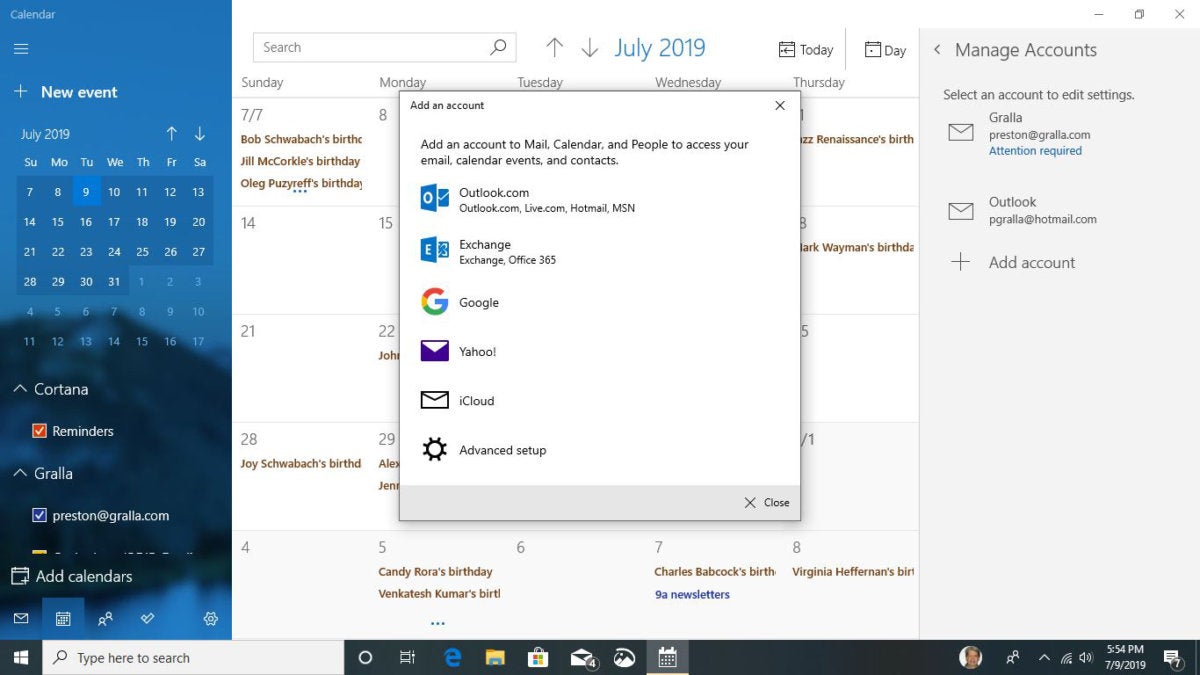 IDG
IDGThat’s all it takes. From now on, your Google calendar will sync with the Windows 10’s Calendar app. So, for example, if you ask Cortana to “create appointment,” you’ll be able to fill in the details using Cortana, including the date, time, and purpose. Cortana will add the event to the Windows 10 Calendar. To save it to your Google calendar directly, choose the calendar from the drop-down list just above the Add button. Regardless of which calendar you add an event to, both Google and Windows 10 Calendar will remain in sync.
Also, when you ask to see your schedule — such as by asking “What’s my schedule today?” — Cortana will show you the events from all of your calendars, including Google.
One downside is that you can’t add events to sub-calendars on Google Calendar (like “home” or “work”) with any regular success. Sometimes it works, and sometimes it doesn’t.
Use Cortana on the lock screen
Did you know you don’t even have to log into Windows to use Cortana? You can work with the digital assistant on right on the lock screen.
To get started: Select Settings > Cortana > Talk to Cortana. Scroll down to the Lock Screen section and move the slider to On. Look just below that for the “Let Cortana access my calendar, email, messages, and Power BI data when my device is locked” setting. Check that box as well. If you don’t, Cortana will be limited in what it can do for you from the lock screen — you’ll be able to listen to music and find out the weather from the lock screen, but you won’t be able to set reminders, send emails, or add events to your calendar.
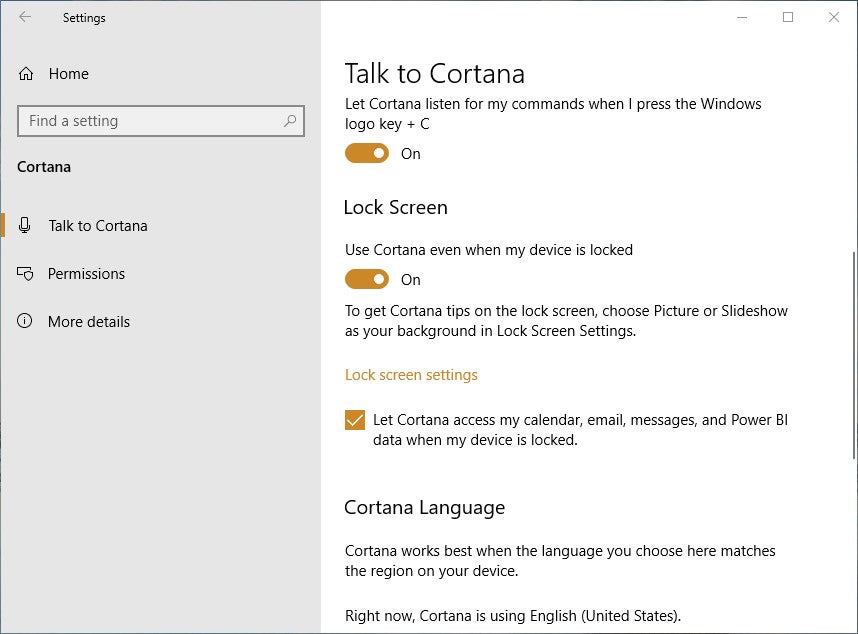 IDG
IDGOnce you’ve done that, when your device is locked you can just say “Hey Cortana” and use it from the lock screen as you normally would, to set reminders, play music, check your calendar, and more without logging into Windows.
Use alternate search engines and browsers with Cortana
When you ask Cortana an open-ended question that requires that it search the web and then display the results in a browser — for example “Why are deepfakes dangerous?” — it uses Microsoft’s Bing search engine to do the search. And it then uses Microsoft Edge to display the results.
If you’ve changed your default browser from Edge to another browser such as Chrome, though, when you ask Cortana an open-ended question, it thinks for a second or two and then ignores you. It doesn’t launch a browser to display the search results. So if you have a default browser other than Edge, Cortana simply won’t work for you when you ask open-ended questions.
However, there’s a workaround that will force Cortana to use Google or another search engine to do its web searches, and another that tells Cortana to use Chrome or another browser to display the results. Note that if you want to force Cortana to use Google or another search engine besides Bing, you’ll need to use Chrome or Firefox. For simplicity’s sake, I’ll give the instructions below for Google Chrome, but the steps are the same for Firefox.
To start, make sure that Chrome is set as your default in Windows 10. Open the Windows 10 Settings app and select Apps > Default Apps. If Chrome isn’t the listed as the default browser, click the web browser icon and select Google Chrome from the list that appears. That makes Chrome your default when you click a link. But you need to do one more thing to force Cortana to use Chrome.
To do that, you’ll have to install a free piece of software called EdgeDeflector. Get the latest version of EdgeDeflector’s self-installing .EXE executable file from GitHub. (The GitHub site also has more information about EdgeDeflector.) After you download the file, run it, and it installs EdgeDeflector in its own folder. After the installation, go to the folder where it was installed and run EdgeDeflector.exe.
Once you do that, Chrome will launch and display results when you ask Cortana an open-ended question.
(Note: EdgeDeflector doesn’t update itself automatically. When Windows 10 gets an update, there’s a chance it could stop working. If that happens, get the latest release of EdgeDeflector’s .EXE file from GitHub and install it.)
Now we’ll tackle the second problem: the fact that Cortana searches the internet using Bing. If you prefer that it instead search Cortana use Google, DuckDuckGo, Yahoo or Baidu search engine, install the Chrometana Pro extension for Chrome.
After you install it, a tab will open asking which search engine you want to use. Click the one you want to use, and from that point on, your search will be done via that search engine, not Bing. Note that Chrometana Pro won’t work unless you first install EdgeDeflector.
 IDG
IDGThere’s also a version of Chrometana Pro for Firefox. To use it, first make Firefox your default web browser, then install Foxtana Pro, and use the same instructions outlined for Chrometana Pro for Chrome.
Use natural-language queries
Cortana is a lot smarter than you think: It lets you use natural-language queries — in other words, make requests of it using plain English (or whatever your language is), rather than having to use specific words.
For example, to send an email to a contact, you can say, “Send an email to Jane Doe.” Cortana will look through your contacts, find the person to whom you want to send the email, and then let you fill out a form onscreen to create and send the email without having to go into a mail app. If you’ve linked your Outlook account to another account, such as a Gmail account, it will look through that as well. And if it finds multiple matches for the person’s name, it will ask you which address you want to send the mail to.
Check your calendar for Cortana-created information
Cortana can automatically add events to your calendar based on emails you receive — for example, it will add airline flight info to your calendar if you receive a flight confirmation via email. Keep in mind, though, that it only does this with mail sent to an Outlook.com account or to corporate Outlook users. If the information goes to a different service, such as Gmail, it won’t work.
Miscellaneous cool stuff
There are a variety of other useful and/or fun things that Cortana can do for you. A few of my favorites:
- You can track packages or flights by saying the flight number or package tracking number.
- You can ask Cortana to perform simple calculations: Just say, “Hey Cortana, what’s five hundred twenty-one times twelve minus twenty-six divided by three?”
- You can snap a picture of a poster for an event, and Cortana will detect the dates on it and ask if you want to create a reminder to attend it.
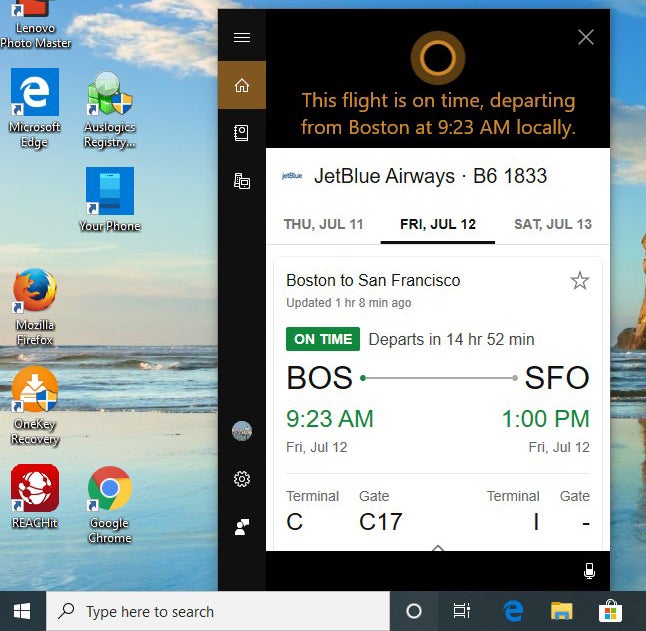 IDG
IDGTo find out other things that Cortana can do, just type or say “help me” and you’ll get a long list of other Cortana features. Click anything on the list — “Play music,” for example — and Cortana will do your bidding.
This article originally appeared on ComputerWorld.

